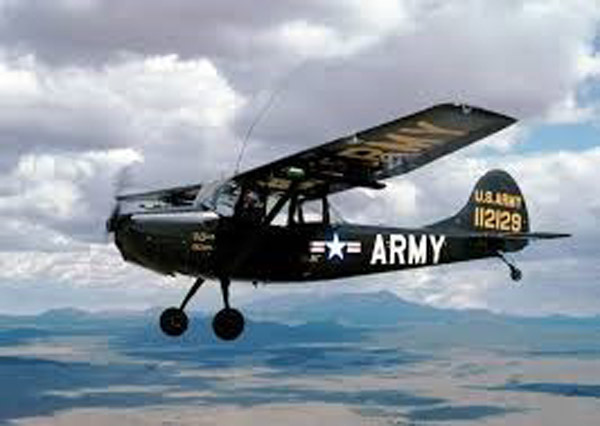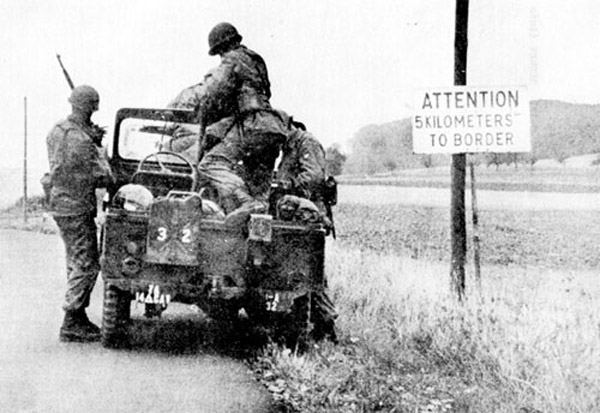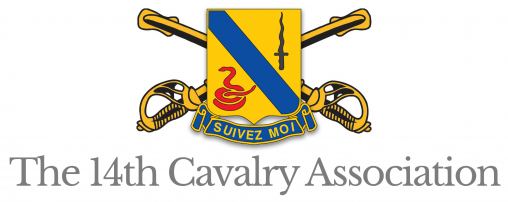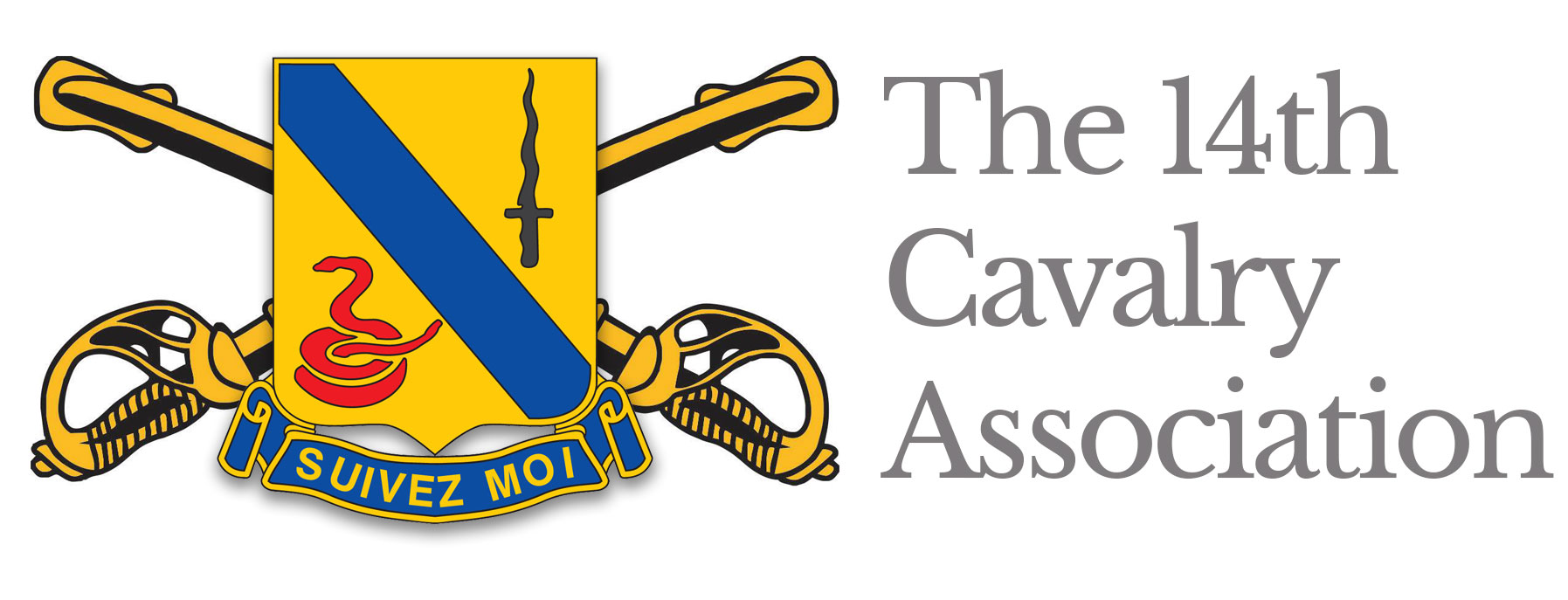Intelligence & the 14th Cavalry Regiment
Upon graduating in 1960 from Indiana University where I had been a cadet in the Reserve Officers Training Corps, I was commissioned a second lieutenant in the Army. My first assignment was to attend the eight-week Infantry Officers Orientation Course at Fort Benning, Georgia, followed by six months of Imagery Interpretation training at the Intelligence School at Fort Holabird, Maryland. We were the first class to study both radar and infra-red imagery (in addition to photo imagery), which were very difficult to interpret due to their poor quality. The future head of the Central Intelligence Agency, Porter Goss, also attended both of these courses at the time. After graduating from the Intelligence School, I was then assigned to the 541st Military Intelligence (MI) Detachment (STRAC) at Ft. Meade, Maryland, part of the 525th MI Group that supported the Department of Defense.
A day after construction of the Berlin Wall began–during the night of August 12-13, 1961–my unit, the 541st MI Detachment (STRAC) received orders on August 14 to deploy to Fulda, Germany, near the historic Fulda Gap. That move to Europe was part of the buildup of 23,000 American troops announced by then President Kennedy in response to the construction of the Berlin Wall.
We were transported to Brooklyn, N.Y. where we boarded a troop transport ship bound for Bremerhaven, Germany, an 8-day transit. We docked in Cherbourg, France before reaching Germany to offload a contingent of troops who were to be stationed in several French locations (mostly in tents, as the French were not too happy to allow American troops on their soil, despite the unfolding international events).
From Bremerhaven we took a train to Frankfurt (location of the U.S. Army’s V (5th) Corps Headquarters) and then boarded another train bound for Fulda, arriving around October 8th, 1961.
Shortly after arriving, I was assigned to the Regimental Headquarters staff as the S-2 Air. Soon hereafter, I qualified as an Aerial Observer. I acquired approximately 125 hours of flight time (mostly border flights along the East-West Inter-Zonal Border) until I departed Fulda in early November of 1962 (shortly after the Cuban missile crisis).
Throughout 1962, we deployed to one of a number of sites in the field, due to Russian provocations or for training purposes. These usually lasted for several days, and were usually “routine,” if any action during this period could be called routine. One issue that became apparent during these exercises was the difficulty of communicating with V Corps Headquarters in Frankfurt over our ground radios. The Corps Commander, Lieutenant Gen. John Waters, decided that, to enhance communication between he and our regimental commander, Colonel James V. Galloway, radio relay was needed until such time as regular communication links were established.
I was selected to perform this task. I did so sitting in the back seat of an L-19 (Bird Dog) fixed wing aircraft, taking advantage of the range of its ARC 44 radio.

While the radio relay flights normally lasted a few hours, there were two exercises which lasted 10-12 hours, during which time we landed every three-plus hours at the Fulda airfield to refuel and/or change pilots. Needless to say, sitting in the back seat of a L-19 for 10-12 hours with a message board on my leg was exhausting, but the most trying thing was to capture the transmissions accurately through the static we all dealt with in monitoring radio transmissions.
The majority of my border surveillance flights were in the H-34 (Choctaw) helicopter, as the three cavalry squadrons on the border conducted round-the-clock ground surveillance by patrolling in jeeps or manning various daytime observation posts (OP’s) or nighttime listening post (LP’s) located along the border.

They were augmented by small radar units that were deployed from time-to-time along the border.
I also made several flights or ground excursions to the border to check out numerous towers that were constructed by the East Germans along the border, the purpose of which, we concluded from conversations with East German work and surveillance patrols, was to prevent East Germans citizens from escaping across the border, the Berlin crossing points having been closed by the Wall. Our border presented many challenges to an escapee, as there was a 10-meter strip of cleared ground, fenced by barbed wire and mined and patrolled regularly by the East German Border Police. On one particular trip, near the 2nd Squadron Headquarters in Bad Hersfeld, we hauled a camera with a 6-foot focal length lens to a spot near the border to take photos of a road checkpoint across the border in East Germany. The East Germans, who spotted our camera on a trailer being towed by a Jeep, became quite excited by the appearance of this “weapon,” as they had never seen such a thing before. After taking a few photos, we evacuated the area, and did not obtain any valuable intelligence as a result of this several hour mission.
My most interesting mission occurred the night that President Kennedy gave his speech (October 25,1962, as I remember) announcing the quarantine of Cuba, which was designed to prevent the transfer of additional missiles to Cuba, the presence of which had been detected earlier by over flights of the island by reconnaissance aircraft (U-2 and Air Force). It was around midnight when the speech ended Fulda time, and we were in our field uniforms at Regimental Headquarters awaiting the wail of the alert siren, a signal to report to our units as soon as possible (ASAP). This did not happen, much to my surprise, but at this point, the Regimental Executive Officer (XO), Lieutenant Colonel Christiansen called me from the S-2 office and directed me to report to him immediately. He then outlined my mission, which was to take a Jeep to our most northern sector and visit all of our border OP’s to our most southern sector, as well as gathering any West German intelligence I could obtain along the way. I do not remember how may OP’s we visited during the night, but I can say that as we approached each OP, we made sure they knew we were “friendlies,” as tensions were obviously quite high along the border following the quarantine. Our main concern was what action, if any, the Russian armor divisions, who were in close proximity to the Inter- Zonal Border, would take on orders from Moscow. I completed my border surveillance around first light, 0700 (7 a.m.) as I recall, and as we drove back to Fulda, a number of West Germans cheered us as we went by, one even throwing flowers in front of our Jeep. I can say that we sat a little more upright “in the saddle” despite a long and tense night.
When I retuned to Regimental Headquarters, I reported to the XO that our squadrons had neither observed nor heard any Russian tank activity along the border during their reconnaissance operations. I then went to the S-2 office and dictated to Sergeant Lockwood, our S-2 Sergeant, a memorandum outlining my contacts during the
early morning hours as well as my findings as reported to the XO. When I finished the memorandum, Sergeant Lockwood looked at me and said, “I sure hope you are right,
lieutenant.” Fortunately, I was.
Needless to say, as the day wore on, I was relieved that the border remained normal, as I already had orders to return to the U.S. and be released from the Army at Ft. Hamilton in N.Y on November 17, 1962, the last day of my two-year commitment.
Willard “Bill” C. Kayser, Jr., First Lieutenant
Regimental S-2 Air
14th Armored Cavalry Regiment
1961-1962

